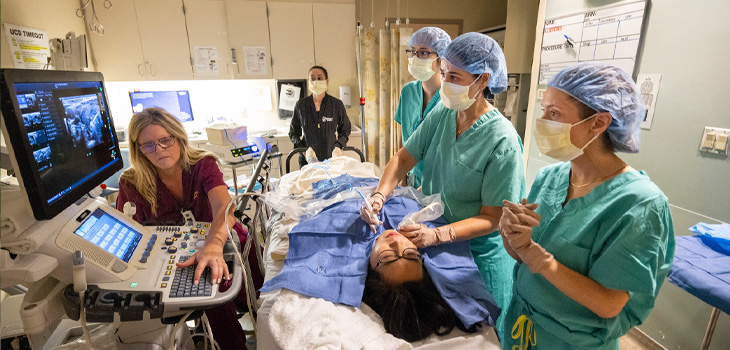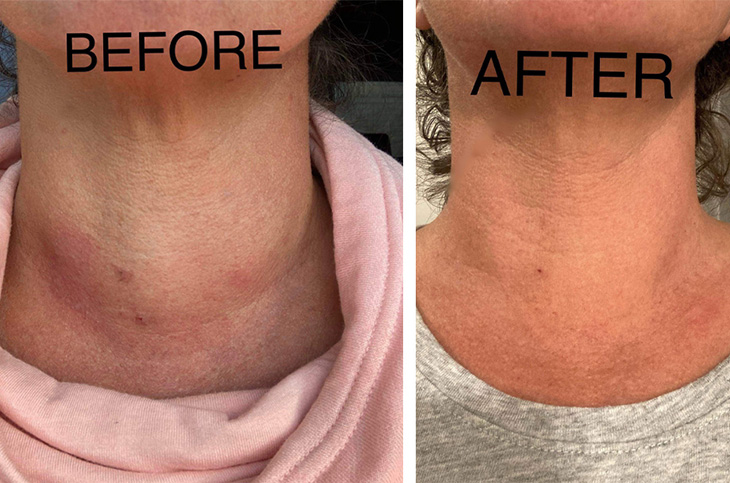
Thyroid nodules are growths that form in the thyroid gland, a small butterfly-shaped gland in the neck. Most are harmless and cause no symptoms, though some can lead to swelling, pressure or changes in hormone levels. While only a small percentage are cancerous, doctors typically evaluate nodules with imaging and possible biopsy to be sure.
A newer treatment called radiofrequency ablation (RFA) offers patients a safe, nonsurgical option. Below, our UC Davis Health experts answer common questions about this procedure and what it can mean for patients.
What is radiofrequency ablation, or RFA?
Radiofrequency ablation (RFA) is a treatment that uses electricity and heat to shrink thyroid nodules. A thin probe, similar to a needle, is placed into the nodule. The tip of the probe sends out energy that destroys the targeted cells. Over time, the nodule shrinks. The procedure takes about 45 minutes and is done with local anesthesia. Patients are awake but the area is numbed.
What is the recovery time after thyroid RFA?
Most people go home the same day and are back to normal activities within one to two days. Some mild swelling or soreness can last a few days, but the thyroid nodule itself shrinks gradually over several months, with the best results seen by six to 12 months.
How painful is thyroid RFA?
The procedure is usually well-tolerated with local numbing. Patients may feel mild heat, pressure or brief pain during treatment and some neck or throat soreness afterward. Over-the-counter pain medicine is usually enough, and overall discomfort is considered mild compared to surgery.
Learn more about thyroid nodule ablation
When is radiofrequency ablation used?
RFA is used for thyroid nodules that are benign, meaning they are noncancerous growths in the thyroid gland at the base of the neck. Doctors may recommend this treatment when a nodule:
- Makes swallowing or breathing uncomfortable.
- Creates a visible lump that changes the way the neck looks.
- Causes enough pressure and irritation that it interferes with daily life.
Learn more about the UC Davis Health Center for Interventional Thyroidology

Who is a good candidate for RFA?
People are typically good candidates if their nodule is:
- Noncancerous and low risk for turning cancerous
- Solid (not just filled with fluid)
- Causing symptoms such as pressure, coughing or difficulty swallowing
For fluid-filled, or “cystic,” nodules, another option called ethanol ablation may be used. In that procedure, the fluid is drained and replaced with alcohol to shrink the nodule.
What are the long-term results and benefits of RFA?
Studies show thyroid nodules shrink by 50–80% by a year after RFA. Many patients notice relief much sooner — sometimes within a few months. The benefits include:
- A smaller or invisible lump
- Less pressure in the throat
- Easier swallowing
- No need for major surgery
Is radiofrequency ablation a better option than surgery?
Both surgery and RFA are safe, good options, and it’s up to the patient to decide which is best to achieve their goals.
How are thyroid surgery and RFA different?
Surgery usually means removing part or all the thyroid gland, which can leave a scar, require 1-2 weeks of recovery and sometimes lead to lifelong thyroid hormone replacement. However, the nodule is completely removed and does not grow back.
RFA is minimally invasive, done in an outpatient setting so patients can go home the same day, and it leaves no scar. Because it is targeted just to the abnormal thyroid tissue, it is less likely to result in the need for ongoing thyroid hormone replacement. However, the nodule does not completely go away and requires ongoing monitoring with ultrasound.
The bottom line: For people with bothersome but noncancerous thyroid nodules, RFA offers a safe, effective and less disruptive alternative to surgery.
See how one UC Davis Health patient benefitted from thyroid nodule ablation
UC Davis Health’s team is committed to advancing your quality of life with thyroid conditions through research and innovation. They strive to bring you the most effective therapies that keep your endocrine system working at its best — and get you back to feeling like yourself.
This blog was medically reviewed by endocrinological surgeon Claire Graves.




